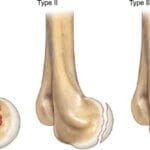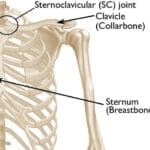Burners and stingers are acute nerve injuries frequently encountered in contact and collision sports. These injuries result from the stretching or compression of nerves in the neck and shoulder, leading to a distinctive burning or stinging sensation that can radiate from the shoulder down to the hand. This sensation is often likened to an electric shock or a lightning bolt running down the arm.
Anatomy of the Brachial Plexus
The brachial plexus is a network of nerves that originates from the spinal cord in the neck and extends through the shoulder into the arm. It comprises nerve roots from the lower cervical and upper thoracic spine (C5 to T1). These nerve roots converge, merge, and branch out to form trunks, divisions, cords, and finally peripheral nerves that control the motor and sensory functions of the shoulder, arm, and hand. This intricate network is responsible for transmitting signals from the brain to these regions, enabling movement and sensation. Damage or irritation to the brachial plexus can result in significant discomfort and impaired function.
Mechanisms of Injury
Burners and stingers occur when the brachial plexus is subjected to a sudden, forceful movement that stretches or compresses the nerves. This typically happens in the following scenarios:
- Lateral Head Movement: When the head is forcefully pushed sideways and down, stretching the nerves on the opposite side of the neck. This is common in sports like football during tackles.
- Shoulder Depression: When the shoulder is pushed downward while the head is pushed in the opposite direction, compressing the nerves. This often occurs during falls or collisions.
- Direct Impact: A direct blow to the neck or shoulder area, which can occur in sports such as wrestling or rugby, where physical contact is frequent.
Risk Factors
Several factors increase the likelihood of sustaining a burner or stinger:
- Contact Sports: Athletes involved in sports that involve physical contact, such as football, rugby, hockey, and wrestling, are at higher risk. The nature of these sports often leads to the types of impacts that cause nerve injuries.
- Spinal Stenosis: A condition where the spinal canal is narrower than normal, which can increase the risk of nerve compression. This can be congenital (present from birth) or develop over time due to degenerative changes in the spine.
- Recurrent Injuries: Athletes who have experienced burners or stingers previously are more likely to suffer from them again, particularly if the underlying risk factors, such as spinal stenosis, are not addressed.
Symptoms
The symptoms of burners and stingers are usually unilateral, affecting one arm. They include:
- Burning or Electric Shock Sensation: A sudden, intense pain that feels like an electric shock travelling from the neck down to the arm.
- Numbness and Weakness: Immediate loss of sensation and strength in the affected arm.
- Warm Sensation: A feeling of warmth or heat in the area where the injury occurred.
These symptoms typically last from a few seconds to several minutes but can persist for hours, days, or even longer in severe cases.
Diagnosis
To diagnose a burner or stinger, a physician will conduct a thorough examination, including:
- Medical History: Discussing the patient’s symptoms and how the injury occurred.
- Physical Examination: Checking for muscle strength, sensation, and reflexes in the affected arm.
- Imaging Tests: While not usually necessary, X-rays, MRIs, or nerve studies may be recommended if symptoms are severe or persistent. These tests help rule out more serious conditions like fractures or severe nerve damage.
Treatment
The primary goal of treatment is to alleviate symptoms and prevent further injury. Key steps include:
- Immediate Rest: Athletes should immediately cease activity to prevent aggravating the injury. They should only return to sports once all symptoms have completely resolved.
- Physiotherapy : If symptoms persist, physical therapy may be necessary to restore strength and flexibility. A therapist can guide exercises to strengthen the neck and shoulder muscles, improving stability and reducing the risk of future injuries.
- Protective Gear: For athletes with a history of burners or stingers, using protective equipment like neck rolls, cowboy collars, or specialised shoulder pads (such as spider pads) can provide additional support and reduce the likelihood of recurrence.
Preventive Measures
Preventing burners and stingers involves several strategies:
- Proper Technique: Learning and practising proper techniques for tackling, blocking, and falling can reduce the risk of injury in contact sports.
- Strengthening Exercises: Regular exercises to strengthen the neck, shoulder, and upper back muscles can provide better support and protection for the brachial plexus.
- Protective Equipment: Consistently wearing recommended protective gear during high-risk activities can help prevent these injuries.
Long-term Management
For athletes with recurrent burners or stingers, long-term management may involve:
- Regular Monitoring: Frequent check-ups with a healthcare provider to monitor the condition and make any necessary adjustments to treatment or preventive measures.
- Lifestyle Adjustments: In some cases, modifying training routines or avoiding certain high-risk activities may be necessary to prevent recurrent injuries.
Prognosis
The prognosis for burners and stingers is generally good, especially with appropriate treatment and preventive measures. Most athletes can return to their sport without long-term effects once their symptoms have resolved. However, recurrent injuries may indicate underlying issues such as spinal stenosis, which may require further medical evaluation and possibly even surgical intervention.
Conclusion
Burners and stingers, while often temporary, require careful management to ensure full recovery and prevent recurrence. Understanding the causes, symptoms, and treatments of these injuries is crucial for athletes, coaches, and healthcare providers. Through proper diagnosis, immediate treatment, and preventive strategies, athletes can safely return to their sports and maintain their physical health. By recognizing the importance of proper technique, protective gear, and physical conditioning, the risk of these nerve injuries can be significantly reduced.





